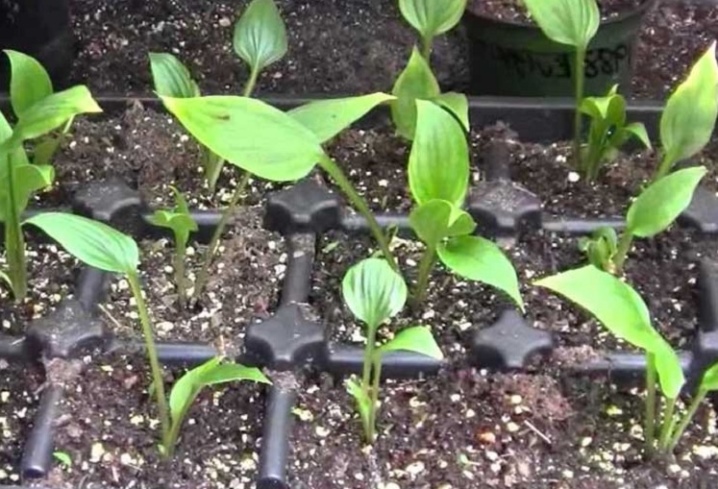Red host: description and agricultural technology

Recent developments of geneticists are aimed at creating plant species, in the color of which there are shades of red or burgundy. So the red host was received. This color gives the culture originality.

History of origin
There are up to 40 types of host. On their basis, genetics obtained a variety of species that serve as decoration of personal plots in most states. The homeland of this culture is the Far East, China, Japan. People first noticed a beautiful plant 3 centuries ago, when it was presented to the public by the Austrian scientist N. Host, and then by the German G. Funke. The second name for hosts is a function.

Characteristic
It is a bush with rather large leaves, which will add uniqueness to any garden. The plant belongs to the lily family and is a perennial. The height of the hosts is from 0.15–1.2 m. The rhizome is miniature, the stems are short, petiolate leaves extend from them. The appearance of the leaves can be anything from narrow to wide.

Varieties
There are types of red hosta, the leaf petioles of which look very original.
- Red october, which translated into Russian means "Red October", with reddish petioles.

- Several years ago appeared First Blush grade ("The first blush") with leaves on a red leg and veins of the same color. A narrow border runs along the edge of the leaf, spreading along the surface in spots as the leaves unfold.

- A variety worthy of attention - Purple haze ("Purple Haze"). The entire surface of the leaf is pale purple in color. It is most noticeable in stark shadow.

- Purple heart ("Purple Heart"). This host was received 7 years ago. Its distinguishing feature is the presence of a dark red spot at the base of the leaves. This is a plant with a red stem, on which flowers of a lilac shade are located. The bush has a vase-like shape. This is the species with the largest presence of red, spreading along the veins of the leaf to its very middle.

- Azuretini. The plant was bred several years ago. It is characterized by green leaves with a silvery sheen on a white lining, reddish petioles and a vase-like type of bush.

- For Fruit variety ("Fruit Punch"), obtained 20 years ago, is characterized by the presence of arrow-shaped leaves of a bright green color, the tips of which are painted in a rich burgundy shade, petioles of the same color. The difference between this variety is the presence of purple flowers with a white stripe along the edge of the petal.

- Red scorpion ("Red Scorpion"). The plant is small with wavy glossy leaves and purple petioles.

- Blueberry muffin ("Blueberry Cupcake"). Heart-shaped leaves of a bluish hue on burgundy petioles.

- Red bull - a variety bred 4 years ago. Has heart-shaped leaves. They are dense, deep green with deep veins, a narrow tip and a white lining.

- Jessica Alba. Very beautiful, slightly curled leaves with a ruffled edge and a white underside with red petioles. In the spring, the tips of the leaves become red in color.

- Almost. It is characterized by glossy green leaves with a small red streak at the base. The stems are burgundy.

- King. It is a large plant with twisted leaves on bright red petioles and scarlet stems.

Planting and leaving
The main feature of the culture under consideration is its unpretentiousness.Hosta tolerates any soil, except sandy and loamy.
Plants can be planted anywhere, they perfectly tolerate shade, drought and normally coexist with the surrounding crops.
The roots of the hosta are long and thick, intertwined. They grow at a high speed, and with their help nutrients enter the aerial part of the plant. The culture propagates by dividing the rhizome.

It is long and impractical to grow hosta from seeds; this method is used in most cases in genetics. If several host varieties grow in the garden at once, you can get a variety of hybrids, because these plants are easily crossed.
If you plant the hosta with seedlings, then with the arrival of spring it is necessary to sow the seeds in a container with fertile soil, while it should be well moistened. Cover the container with glass on top. A little more than half a month will pass, and seedlings will appear. Protect them from direct sunlight. When a pair of leaves appears, a dive is made.

Another way of planting hosts is with the help of seedlings, which must be purchased in the autumn, when the growing season is over, but there is still time for rooting. It is necessary to place the resulting culture, taking into account its long-term growth. As it grows, the size of the occupied area increases.

For a culture to have a beautiful appearance and delight the eye, it needs to create optimal conditions.
- Temperature regime and humidity level. Love for these plants is due to the fact that they do not differ in demanding care and growing places. They tolerate drought and temperature fluctuations well. They grow well in the shade of trees and shrubs and on the northern slopes.
- Watering. The host loves moist soil, but moisture should not stagnate on it, because this will lead to decay of the roots.
- Fertilization. Plant feeding is carried out in the spring or during transplantation for better rooting.
- Pruning is done after flowering.
Hosta is generally not susceptible to various types of diseases. It happens that it is affected by fungus or rot.
The greatest harm is caused by snails, caterpillars and locusts, which eat up the green mass.

How to apply the host her history and agricultural techniques in the next video.







































































































The comment was sent successfully.